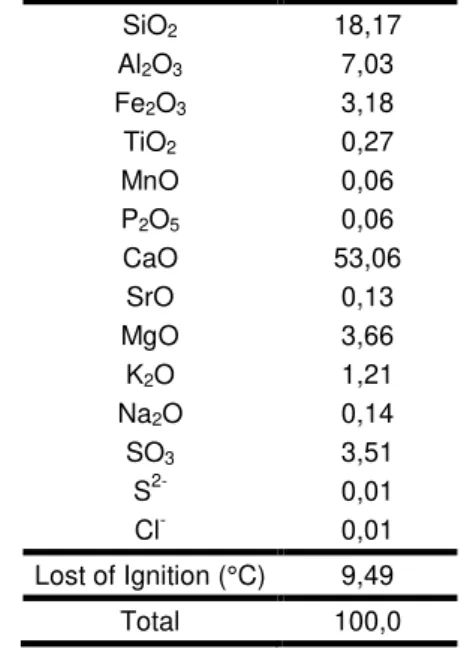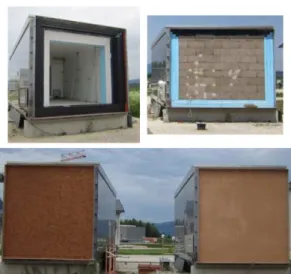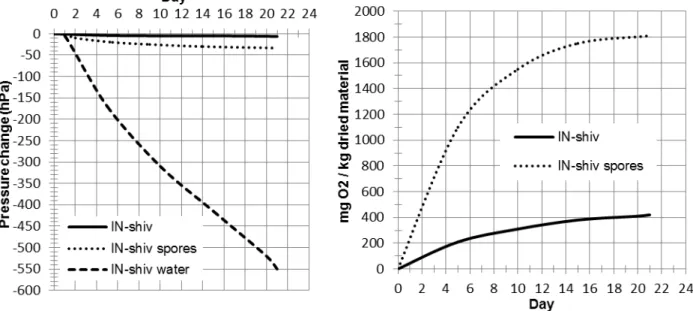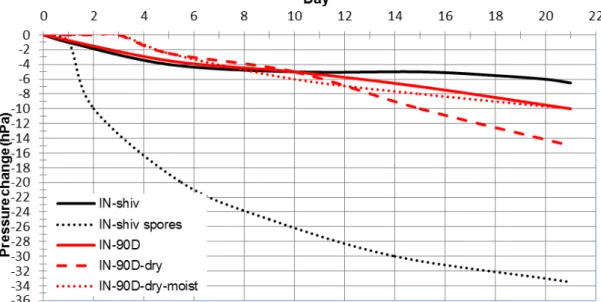First International Conference on Bio-based Building Materials June 22nd - 24th 2015 Clermont-Ferrand, France
STUDY THE DEVELOPMENT OF MOULD ON PROMPT NATURAL
CEMENT-BASED HEMP CONCRETE
L. Bessette1*, B. Trémerie1, T. Béjat2, A. Piot2, A. Jay2, L. Barnes Davin1 1 VICAT, 4, rue A. Bergès, Les Trois Vallons, 38080 L’Isle d’Abeau, France
2 CEA/LITEN, 50 avenue du Lac Léman, 73375 Le Bourget du Lac, France *Corresponding author; e-mail: laetitia.bessette@vicat.fr
Abstract
The use of bio-based materials in construction is significantly improving. One of the bio-based materials is hemp concrete which is a composite obtained by mixing a binder and the non-fibrous part of hemp, called shiv. This specific hemp concrete developed by Vicat is made with Prompt Natural Cement (PNC). Hemp concrete is used for its insulating properties and its capacity to control humidity which is obtained due to the hydrophilicity of shiv. Therefore to reach the same level of binder hydration more water is needed in hemp concrete than in traditional concretes. This excess of water combined with insufficient drying of hemp concrete may quickly lead to the development of mould. In fact, the binder alkalinity is not sufficient to stop the microorganism development. This study presents results from two tests to quantify mould development in PNC-based hemp concrete. The first series of test was carried out respectively on the shiv only and on hemp concrete specimens which were a few hours and a few days old. During the first 24 hours the number of microorganisms identified on hemp concrete specimens decreases more significantly than on the raw shiv. So the hemp concrete formula prevents concrete from developing mould. A second part of the study was carried out on a hemp concrete of same formula than previously but coated with two different renders: one coating permeable to both liquid and vapour water while the second one is permeable to vapour water but not to liquid water. The coated hemp concretes had been exposed to external conditions for four seasons. After one year, some samples were removed in order to study the microorganism development. The tests show that the exterior coating must be well chosen. Using a waterproof coating which is permeable to moisture does not present development of mould.
Keywords:
Hemp concrete, Prompt Natural Cement, mould, durability, coating
1 INTRODUCTION
The use of bio-based materials in construction is significantly improving in order to decrease the environmental impact of construction materials and the energy consumption of building heating and air conditioning [Amziane 2013]. The market for bio-based materials has increased approximately 6% between 2012 and 2014 in France [TBC 2014]. The bio-based materials are vegetal fibers like wood, straw, bamboo, hemp, sunflower and also sheep wool. One of the most used bio-based materials in construction is hemp concrete. Hemp concrete is a composite obtained by mixing a binder and the non-fibrous part of hemp, called shiv. This bio-based concrete is used for its insulating properties and its capacity to control humidity [Collet 2013]. This latter specification is obtained due to the hydrophilicity of shiv. Indeed, shiv absorbs three time its weight within a few minutes. That is why the formulation of hemp concrete has to be optimized as more water is used in hemp concrete than in ordinary concretes. As a result the
water-cement ratio is often close to 1 [Amziane 2013]. This excess of water combined with insufficient drying of hemp concrete may lead to the development of micro-organisms. Mould can quickly appear on the surface of the concrete as it had happened on Figure 1. The alkaline in the binder is not sufficient to stop the development of mould.
The micro-organisms must affect the durability of bio-based materials since some bacterial and fungal feed of cellulose, a component of vegetal fibers. That is why the study of ageing and durability is important to improve the success of hemp concrete. However, today few analyses have been carried out on this issue. Some studies [Sedan 2007] [Magniont 2010] [Diquélou 2014] focused on the inhibition or delayed setting due to the dissolution of cellulose, hemicellulose and lignin which conduct to polysaccharides and polyphenol formation. Fortunately this phenomenon is not observed with Prompt Natural Cement because its setting time is few minutes. The effect of wetting/drying cycles to simulate natural variations of humidity on hemp concretes [Hellebois
2013] had been determined. The results demonstrated that cycles can influence the mechanical and thermal properties.
Fig. 1: Mould development on hemp concrete surface
Some hemp concretes made with hydraulic lime [Walker 2014] had been submitted to freeze-thaw and then exposed to salt. The freeze-thaw resistance is greater with binders of high hydraulicity. And the hemp concretes are not damaged by the salt due to the high ductility of the pore accommodating salt crystallization. The fungal development had also been studied: hemp concrete had been inoculated with micro-organisms often found in soil and air. The tests shows that the hemp concretes resist to biodeterioration when humidity alternates with drying period.
In this paper, a study of ageing of hemp concrete made with Natural Cement Prompt is proposed, specifically its resistance to micro-organisms development during the manufacturing and its use.
2 MATERIALS AND METHODS 2.1 Materials studied
The bio-based material studied is a specific hemp-concrete developed by Vicat. This hemp-hemp-concrete is specific from two aspects.
Tab. 1: Typical chemical composition of Prompt Natural Cement (in percentage weight)
SiO2 18,17 Al2O3 7,03 Fe2O3 3,18 TiO2 0,27 MnO 0,06 P2O5 0,06 CaO 53,06 SrO 0,13 MgO 3,66 K2O 1,21 Na2O 0,14 SO3 3,51 S2- 0,01 Cl- 0,01 Lost of Ignition (°C) 9,49 Total 100,0
First, hemp-concrete is made with Prompt Natural Cement (PNC) [Avenier 2007]. This natural hydraulic binder is mined from a single geological layer of argillaceous limestone, a sedimentary rock formed during the formation of the Alps. It is fired between 800 and 1200°C, a temperature lower compared to Ordinary Portland Cement (OPC) production but
comparable to lime production. Then it is finely ground without other additive. Its chemical composition is presented in table 1. The setting time of natural binder is very short, few minutes. That’s why PNC is a favourite for manufacture hemp concrete because the delayed setting due to the shiv degradation molecules is not observed.
Fig. 2: photos of Precast Interlocking Blocks Vicat of hemp concrete
The second aspect of the specificity of the hemp concrete is the patented Precast Interlocking Blocks (PIB) system (Figure 2). The advantage with these precast blocks is neither mortar nor joint are necessary [Baumer 2010]. They measures 30cm of width, 30cm of height and 60cm of length. And they have some grooves and tabs in order to assemble blocks together and for the structure in concrete. The PIB is obtained by mixing 126kg of shiv of hemp, 165kg of hydraulic binder with Prompt Natural Cement and 180 kg of water. Then the mix is compressed in a mould. After drying for several days, PIB Vicat are ready to use. The specific density of this hemp concrete is comprised between 320 and 350 kg/m3. And the compressive strength is 0.6 MPa, they support their own weight but they are not structural.
The shiv used to produce the PIB is a commercial product (Chanvribat – LCDA France). Its bulk density is between 100 to 110 kg/m3.
2.2 Experimental investigation Two tests were carried out in parallel
Study up to 90 days in inside climate
The first series of test was carried out respectively on the shiv only and on PIB specimens which were a few hours and a few days old, up to 90 days. The table 2 presents the description of specimens. Shiv and PIB were kept in warehouse between 5 and 15 °C and 60% relative humidity. So these specimens were stored at room climate. The sample removed on PIB 90 days after manufacturing had been dried at 50°C during 48 hours, then moistened again in order to simulate water damage. Specimens were analysed in order to check the risk of mould development.
Study up to one year in external climate
A second part of the study was carried out on PIB coated and used in walls in two PASSYS test cells [Béjat 2013] which are adiabatic rooms of around 30 m3 volume each (Figure 3). For each cell, one test wall is built with PIB while the five other walls are highly insulated and are non-tested walls. The two test cells are next to each other. Tested walls are south oriented and are subject to weather solicitations outside and hydrothermal regulation inside.
Fig. 3 : Photos of PASSYS cells – A: cell without tested wall – B: Cells with PIB Vicat hemp concrete –
C: Cells with coated hemp concrete
The PIB of one PASSYS cell had been coated with an industrial exterior coating - TRADI MORTIER 400
©VPI and RENOJET FGT ©VPI, supplied by Vicat
Produits Industriels (VPI) - which is permeable to vapour water but not to liquid water. The PIB of the second PASSYS cell had been coated with an artisanal exterior coating which is permeable to both liquid and vapour water. On the hemp concrete of two PASSYS cells, a coating with sand and lime had been
applied on the indoor face. PIB had been exposed to external conditions for four seasons at Le Bourget du Lac (France). The climate is mainly temperate up to mountain. Then the walls had been submitted to outdoor conditions during one year with frost, rain, humidity and sun on the one side, to indoor climate on the other side, i.e. close to real use conditions.
After one year, three samples of hemp concrete on each cell were removed in order to study the microorganism development. First hemp concrete was removed behind the interior coating, the second at the middle of the block and the third was behind the exterior coating (figure 4). The table 2 summarises all specimens.
Fig. 4: Samples removed from PIB – 1: behind the interior coating - 2: at the middle of the block 3: behind
the exterior coating Tab. 2: Specimens references
Reference Kind of study Description IN-shiv inside climate shiv
IN-shiv water inside climate shiv where water sterilized had been sprayed IN-shiv spores inside climate shiv where mould spores had been sprayed
IN-1D inside climate Specimen removed 1 day after manufacturing on PIB IN-15D inside climate Specimen removed 15 day after manufacturing on PIB IN-30D inside climate Specimen removed 30 day after manufacturing on PIB IN-60D inside climate Specimen removed 60 day after manufacturing on PIB IN-90D inside climate Specimen removed 90 day after manufacturing on PIB
IN-90D-dry inside climate Specimen removed 90 day after manufacturing on PIB and dried at 50°C during 48 hours
IN-90D-dry-moist inside climate Specimen removed 90 day after manufacturing on PIB, dried at 50°C during 48 hours and moistened OUT-ind-int PIB exposed one year at outside climate Specimen removed from the PASSYS room with an industrial exterior coating. The sample of hemp concrete placed behind the interior coating OUT-ind-core PIB exposed one year at outside climate Specimen removed from the PASSYS room with an industrial exterior coating. The sample of hemp concrete placed at the core of blocks OUT-ind-ext PIB exposed one year at outside climate Specimen removed from the PASSYS room with an industrial exterior coating. The sample of hemp concrete placed behind the exterior
coating
OUT-art-int PIB exposed one year at outside climate Specimen removed from the PASSYS room with an artisanal exterior coating. The sample of hemp concrete placed behind the interior coating OUT-art-core PIB exposed one year at outside climate Specimen removed from the PASSYS room with an artisanal exterior coating. The sample of hemp concrete placed at the core of blocks OUT-art-ext PIB exposed one year at outside climate Specimen removed from the PASSYS room with an artisanal exterior coating. The sample of hemp concrete placed behind the exterior
2.3 Microbiologic analysis
Two tests were carried out on samples of hemp concrete.
Test inspired by NF EN ISO 14851standard
First, in order to check the stability of the risk of mould development, the standard NF EN 14851 [NF EN 14851] and the Stürm test [OECD 1992] were adapted. The Stürm test is used as reference in the biodegradation of materials. Then this study analyses the microbial activity which is determined by the oxygen consumption in aerobic condition. 20g of each sample is placed in a sealed reactor equipped with a pressure sensor (Oxitop® System supplied by Global Water) [Oxitop]. The breathing of micro-organisms implies oxygen consumption in the reactor so pressure change. The CO2 is trapped by soda. The pressure changes are measured in continuous by the Oxitop sensor during 21 days, transferred by infrared and saved by the Oxitop OC110 system. Next to calculate the oxygen consumption corresponding to pressure changes, the material was dried at 105°C during 10 minutes. The results are presented in pressure change (hPa) and oxygen consumption (mg O2/kg of dried material). Since the system is sealed closed, a decrease of pressure is caused by the oxygen consumption by microorganisms. On the contrary, an increase of pressure means that a gas is released (except the CO2 because it is trapped by soda). This test was carried out on samples from PIB stored inside and aged for few hours to 90 days. The tests was repeated twice or three times. Furthermore, in order to evaluate the risk of micro-organisms development, some analyses were carried on shiv only, shiv which has been sprayed with sterilized water and shiv which has been sprayed with water containing mould spores.
Test of counting microorganisms
The objective of the second test is to quantify the micro-organisms (bacterial and fungal) present revivable. Viable is defined that the cells have the ability to multiply under controlled conditions. Sample is placed in Petri dishes with PCA standard (Plate
Count Agar) which is a microbiological growth medium used to assess viable microorganism growth at 30°C. PCA is not a selective medium. Then the micro-organisms are enumerated by microscopic evaluation. All cells are counted (dead and alive). Results are expressed in CFU/g, colony forming unit per gram. If the value is lower than 9.103 CFU/g, the development of microorganism is stopped. If the quantity is between 1.104 and 1.106 CFU/g, the risk to develop mould or bacteria begins to be critical. If the quantity is greater than 1.106 CFU/g the risk is important if sample is placed at temperature and humidity favourable. The advantage of the method is that different microbial species may give rise to colonies that are clearly different from each other, both microscopically and macroscopically. The colony morphology can be of great use in the identification of the microorganism present.
For this test, 3g of hemp concrete were added with 30mL of thinner to obtain first, a dilution 1 up to 10-4. The end dilution were placed in PCA culture medium and incubated at 30°C during 48 hours and 24 hours. 3 RESULTS AND DISCUSSION
3.1 Test inspired to standard NF EN ISO 14851 First, two specimens of shiv, shiv where water sterilized had been sprayed and shiv where mould spores had been sprayed, had been submitted at test inspired to standard NF EN ISO 14851. The results are presented in figure 5. The pressure change on shiv (IN-shiv) is only -10hPa. It is regarded as not significant like the oxygen consumption correspondent. However the spores addition on shiv decreases (IN-shiv spores) the pressure and raises the oxygen consumption. Then the microbial activity increases. And the sterilized water addition is more prejudicial than the spores addition. Indeed the pressure change of shiv with sterilized water drops up to -550 hPa whereas pressure change of the shiv with spores decreases up to – 8hPa. So even sterilized water increases greatly the microbial activity. Specimens with water and spores are used as control specimens.
Fig. 5: Test inspired to standard NF EN ISO 14851 results for shiv samples in pressure change and in oxygen consumption
The results of hemp concrete specimens are presented on figure 6 (only the pressure changes are presented). The one-day old specimen (IN-1D) presents a decrease in pressure change; the magnitude is the same that the shiv with spores (25, -30 hPa). However there are some variations in the pressure due to the chemical reactions in the system which consumes O2. The same observation is done for the 15 day old specimen IN-15D) but at the end of the test (21 days), the pressure change is only – 5hPa, like the sample of shiv (IN-shiv).
For the specimens removed 30, 60 and 90 days after manufacturing (IN-30D, IN-60D and IN-90D), the pressure change is lower than samples removed 1 day after manufacturing (IN1D) varying between 10 and
-14 hPa. These results prove that the microbial activity is not apparent.
The specimen removed on PIB 90 days after manufacturing had been dried at 50°C during 48 hours, then moistened again in order to simulate water damage. These two specimens are also studied. The results are presented on figure 7. The pressure change of hempconcrete dried (IN-90D-dry) is -15 hPa. The microbial activity is more important than the sample non-dried but the activity is low. The pressure change of the sample dried and moistened (IN-90D-dry-moist) is -10 hPa like the sample undried (IN-90D). Therefore the drying and the fact to add water after the drying do not modify the microbial activity.
Fig. 6: Test inspired to standard NF EN ISO 14851 results
So these tests prove that the manufacturing of hemp concrete limits the microbial activity although water is added to make hemp concrete when the concrete is stored inside, without rain.
3.2 Counting test
Later on specimens had been submitted of counting test. The results for specimens stored inside are presented on the figure 8. Shiv contains a quantity of revivable micro-organisms important and critical; more than 1.106 CFU/g. Shiv is a vegetal which is wholesome and this result is evident. Fortunately, hemp concrete removed after manufacturing from 1st day, contains low revivable micro-organisms, between 1.5.103 and 1.5.104. It is regarded as no risk; this value is in agreement with our daily environment. Regarding samples 90 days after manufacturing (IN-90D, IN-90D-dried, IN-90D-dried-moist), the drying does not increase risk of micro-organism development. And on the specimen dried and moistened, quantified revivable micro-organisms stay in low number. So when the hemp concrete is stored after its manufacturing inside, sheltered from the rain and at a temperature included between 5 and 15°C, the bacterial and fungal development is stopped.
Some samples removed from the wall exterior are studied. The figure 8 presents also the results obtained. The shiv is used as reference. On the room with industrial exterior render, the revivable micro-organisms are limited whatever the place where the specimens were removed from, the rate is lower than 1.104 CFU/g. So the industrial exterior coating which is permeable to vapour water but not to liquid water protects efficiently the hemp concrete against rain. However samples removed from the room with artisanal exterior render present different results. The samples removed from behind interior coating and at core do not present risk, the rate is below 1.104 CFU/g but the specimen from behind the exterior render developed important micro-organisms. This result is due to the render which is permeable both to the liquid and vapour water. The render absorbs rain and water which are stored in it then in the hemp concrete. This water cannot evaporate easily. So micro-organisms are prone to appear. Therefore the choice of exterior render is very important for the durability of hemp concrete.
Fig.8: Test of counting results
4 CONCLUSION
This paper investigates the micro-organisms development on Precast Interlocking Blocks Vicat in hemp concrete made with Prompt Natural Cement. The first conclusion, despite the fact that shiv microbial activity is critical, when PIB is produced and then stored inside (5-15°C, 60% of humidity relative), its microbial activity is stopped.
Then the durability of samples removed from walls after one year, of exposition to weather conditions, depends on the render used on the hemp concrete. The choice of coating is fundamental to prevent hemp concrete from bacterial and fungal development. It is necessary to apply a waterproof render that is also permeable to moisture to stop development of mould like the coating composed of TRADI MORTIER 400
©VPI and RENOJET FGT ©VPI.
To guarantee a durability of hemp concrete, the materials have to be protected from water and humidity. If the material is in contact with water, in case for example of water damage, a sufficient drying is essential.
In order to increase knowledge about micro-organisms durability of hemp concrete, the carbonation state of concrete must be taken into account. In fact, the bacterium and fungus may form more quickly with a low pH. And the alkalinity depends on the carbonation of the binder and so on its historical moisture.
5 ACKNOWLEDGMENTS
The authors wish to thank CONIDIA which carried out the micro-organisms tests and Mr Vacher for fruitful discussions. They also want to thank VPI and M. Baumer who built the walls.
6 REFERENCES
[Amziane 2013]: Amziane, S., Arnaud, L. ; Bio-aggregate-based Building Materials, Applications to Hemp Concrete. ISTE Ltd John Wiley & Sons, Inc. 2013, ISBN 978-1-84821-404-0.
[Avenier 2007] : Avenier, C., Rosier, B., Sommain, D., Ciment Naturel, Editions Glénat ISBN : 978-2-7234-6158-0
[Baumer 2010]: Brevet FR2961538B1 – demandeur Baumer, D.- Procédé de fabrication d’un édifice à partir de briques à emboîtements à joints secs
[Collet 2013]: Collet, F., Chamoin, J., Pretot, S., Lanos, C.; Comparison of the hygric behaviour of three hemp concretes. Energy and Buildings, March 2013, 62, 294-303
[Béjat 2013]: Béjat, T.; Jay, A.; Lagesse, A.; Piot, A. ; Hygrothermal behavior of a hemp concrete and numerical approach., Proceedings Building and simulation 2013, 3554-3561
[Diquélou 2014]: Diquélou, Y., Gourlay, E., Arnaud, L., Kurek, B. ; Impact of hemp shiv on cement setting and hardening : influence of the extracted components from the aggregates and study of the interfaces with the inorganic matrix, Cement and Concrete Research, September 2014, 55, 112-121
[Hellebois 2013]: Hellebois, P., Marceau, S., Gueguen, M., Amziane, S., Influence of wetting-drying cycles on
the mechanical, physico-chemical, and microstructural properties of hemp concretes, 7th International RILEM symposium on Self-Compacting Concrete, France 2013.
[Magniont 2010]: Contribution à la formulation et à la caractérisation d’un éco-matériau de construction à base d’agroressources, PhD Thesis, Toulouse, 2010 [NF EN 14851]: Évaluation de la biodégradabilité aérobie ultime des matériaux plastiques en milieu, 2004
[OECD 1992]: OECD GUIDELINE FOR TESTING OF CHEMICALS- Ready Biodegradability-Adopted by the Council on 17th July 1992- 18-24
[Oxitop]: http://www.globalw.com/products/oxitop.html [Sedan 2007]: Sedan, D., Etude des interactions physic-chimiques aux interfaces fibres de chanvre/ciment – Influence sur les propriétés mécaniques du composites, PhD Thesis, Limoges 2007.
[TBC 2014]: Vounatsos, A. ; Trébulle, J. ; Etude de marché : L’isolation thermique des murs et des toitures en France - Edition : Juillet 2014
[Walker 2014]: Walker, R.; Pavia, S.; Mitchell, R.;Mechanical properties and durability of hemp-lime concretes. Construction and Building Materials, April 2014, 61, 340-348



